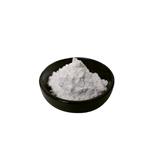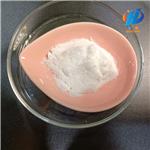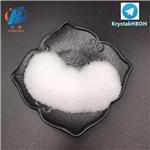- Sodium formate
-

- $6.00 / 1KG
-
2024-04-22
- CAS:141-53-7
- Min. Order: 1KG
- Purity: More than 99%
- Supply Ability: 2000KG/Month
- Sodium formate
-

- $50.00 / 1kg
-
2024-04-18
- CAS:141-53-7
- Min. Order: 1kg
- Purity: 99.10%
- Supply Ability: 50000kg
- Sodium formate
-

- $1.00 / 1KG
-
2024-04-18
- CAS:141-53-7
- Min. Order: 1KG
- Purity: 99.91%
- Supply Ability: 200000
|
| | Sodium formate Chemical Properties |
| Melting point | 259-262 °C (lit.) | | Boiling point | 360 °C | | density | 1.16 g/mL at 20 °C | | vapor pressure | 0Pa at 25℃ | | storage temp. | Store at +5°C to +30°C. | | solubility | H2O: 8 M at 20 °C, clear, colorless | | pka | 3.86[at 20 ℃] | | form | Crystalline Powder | | color | White to off-white | | Specific Gravity | 1.92 | | Odor | Slight formic acid odour | | PH Range | 7 - 8.5 | | PH | 7.4(1 mM solution);7.83(10 mM solution);8.25(100 mM solution);8.57(1000 mM solution) | | Water Solubility | Soluble | | Sensitive | Hygroscopic | | λmax | λ: 260 nm Amax: 0.02
λ: 280 nm Amax: 0.01 | | Hydrolytic Sensitivity | 0: forms stable aqueous solutions | | Merck | 14,8621 | | BRN | 3595134 | | Stability: | Stable. Incompatible with strong oxidizing agents, strong acids. Protect from moisture. | | LogP | -2.1 at 20℃ | | CAS DataBase Reference | 141-53-7(CAS DataBase Reference) | | NIST Chemistry Reference | Sodium methanoate(141-53-7) | | EPA Substance Registry System | Sodium formate (141-53-7) |
| | Sodium formate Usage And Synthesis |
| Chemical properties | It is a white powder, with water absorption and a slight odor of formic acid. It is dissolved in water and glycerol, slightly soluble in ethanol and insoluble in ether. | | Solubility in water | Dissolved quantity per 100 ml of water at different temperatures (℃) in grams:
43.9g/0 ℃, 62.5g/10 ℃, 81.2g/20 ℃, 102g/30 ℃, 108g/40 ℃
122g/60 ℃, 138g/80 ℃, 147g/90 ℃, 160g/100 ℃ | | Sodium formate and calcium formate | Sodium formate and calcium formate are two kinds of common metal salts of formic acid, sodium formate, also known as sodium formate, There are two kinds of molecular forms of sodium formate compounds in nature:
① as a white crystalline powder, anhydrous sodium formate is slightly hygroscopic, poisonous. The relative density is 1.92 (20 ℃), m.p. is 253 ℃. It is dissolved in water, slightly soluble in ethanol and insoluble in ether.
② sodium formate dihydrate is colorless crystals. With slight formic acid odor, it is toxic. It is dissolved in water and glycerine, slightly soluble in ethanol. It broke down into hydrogen and sodium oxalate under strong heat, and finally converted into sodium carbonate. It is produced by the interaction of formic acid and sodium hydroxide.
The main purpose of sodium formate as follows:
Sodium formate can be used as chemical analysis reagent, used for determination of arsenic and phosphorus, also used as a disinfectant, mordant and so on. Powdered sodium formate is used in industrial instand of formic acid to improve the performance of limestone FGD systems, the advantage is application safety and health.
Preparation of sodium formate: Sodium bicarbonate reacts with formic acid in laboratory, remain the solution basic, remove Fe3 +, filtered, and add formic acid into the filtrate, and the solution was acidic, then evaporate, crystallize to obtain crude sodium.
Calcium is a free-flowing white crystalline powder, with mouldproof, fungicidal, antibacterial effects, is an organic acid feed additive. Its content is 99%, with 69% formic acid, 31% calcium, low water content. This product has a high melting point, is not easy to be destroyed in the particle mass. Feed is added 0.9% to 1.5%. This product is broken down into formic acid in the stomach, reduces the pH of the stomach, maintains digestive acidity, prevents the growth of bacteria to control and prevent bacterial infection-related diarrhea. Trace acid activates pepsinogen role in enhancing the absorption of active ingredients in feed, and producing chelation with minerals in feed to promote digestion and absorption of minerals, also be used as a supplement of calcium. For the prevention of diarrhea of piglets and improve survival, promote feed conversion and daily gain.
The above information is collected and finished by Xiaonan of Chemicalbook. | | Uses | 1. Sodium formate is mainly for the production of formic acid, oxalic acid and insurance powder and so on.
2. It is used as the reagent for the determination of phosphorus and arsenic, disinfectant and mordant.
3. It is used as preservatives, with diuretic effect. It is mutatis mutandis in EEC countries, but the British are not allowed to use.
4. Sodium formate is used as intermediates in the production of formic acid and oxalic acid, but also for the production of dimethyl formamide, also used in medicine, printing and dyeing industry. It is also heavy metal precipitant.
5. It is used as alkyd paints, plasticizers, high explosives, acid-resistant materials, aviation lubricants, additives of adhesives.
6. It is used for precipitating noble metal, may form trivalent metal complex ions in the solution. With buffer effect, it can be used for correcting pH value of strong mineral acids to be higher. It is precipitant of heavy metal. | | Production method | 1. It is obtained in industrial by the reaction of carbon monoxide with sodium hydroxide at 150-170 ℃, about 2MPa. In fact, the production process of sodium formate is part of the production of sodium oxalate, the concentration of sodium hydroxide solution for absorbing the reaction was 25%-30%. Sodium formate can be produced by the reaction of formic acid with oxygen or sodium bicarbonate. Material consumption fixed: Carbon monoxide (> 28%) 1630kg/t, caustic soda (> 30%) 2160kg/t. 2. It is the byproduct of pentaerythritol.
2. It is obtained by the reaction of carbon monoxide with sodium hydroxide at 160 ℃, 2MPa. | | Description | Sodium formate, HCOONa, is the sodium salt of formic acid, HCOOH. It usually appears as a white deliquescent powder. | | Chemical Properties | white crystals | | Physical properties | White crystals; slightly hygroscopic; faint odor of formic acid; density 1.92 g/cm3; melts at 253°C; decomposes on further heating, first forming sodium oxalate and hydrogen and then sodium carbonate; very soluble in water; the aqueous solution neutral, pH about 7; soluble in glycerol; slightly soluble in alcohol; insoluble in ether. | | Uses | Precipitant for noble metals. | | Uses | Sodium formate is used in several fabric dyeing and printing processes. It is also used as a buffering agent for strong mineral acids to increase their pH, and as a food additive ( E237 ) . | | Uses | In dyeing and printing fabrics; also In animal chemistry as a precipitant for the "noble" metals. Solubilizes trivalent metal ions in solution by forming complex ions. Buffering action adjusts the pH of strong mineral acids to higher values. | | Definition | ChEBI: An organic sodium salt which is the monosodium salt of formic acid. | | Preparation | Sodium formate can be prepared in the laboratory by neutralizing formic acid with sodium carbonate. It can also be obtained by reacting chloroform with an alcoholic solution of sodium hydroxide.
CHCl3 + 4NaOH → HCOONa + 3NaCl + 2H2O
or by reacting sodium hydroxide with chloral hydrate.
C2HCl3(OH)2 + NaOH → CHCl3 + HCOONa + H2O
The latter method is, in general, preferred to the former because the low aqueous solubility of CHCl3 makes it easier to separate out from the sodium formate solution, by fractional crystallization, than the soluble NaCl would be.
For commercial use, sodium formate is produced by absorbing carbon monoxide under pressure in solid sodium hydroxide at 160 °C.
CO + NaOH → HCOONa
Sodium formate may also be created via the haloform reaction between ethanol and sodium hypochlorite in the presence of a base. | | General Description | Sodium formate is the colorless sodium salt of formic acid. It can be prepared by reacting formic acid with sodium hydroxide or carbonate. Its crystal structure has been investigated. Its crystals exhibit monoclinic-holohedral symmetry. | | Flammability and Explosibility | Not classified | | Safety Profile | Moderately toxic by ingestion, intravenous, and subcutaneous routes. Combustible when exposed to heat or flame. When heated to decomposition it emits toxic fumes of NazO. See also FORMIC ACID. | | Purification Methods | A saturated aqueous solution at 90o (0.8mL water/g) is filtered and allowed to cool slowly. (The final temperature should be above 30o to prevent formation of the hydrate.) After two such crystallissations, the crystals are dried in an oven at 130o, then under high vacuum. [Westrum et al. J Phys Chem 64 1553 1960, Roecker & Meyer J Am Chem Soc 108 4066 1986.] The salt has also been recrystallised twice from 1mM DTPA (diethylenetriaminepentaacetic acid, which was recrystallised 4x from MilliQ water and dried in a vacuum), then twice from water [Bielski & Thomas J Am Chem Soc 109 7761 1987]. [Beilstein 2 IV 3.] |
| | Sodium formate Preparation Products And Raw materials |
| Raw materials | Sodium hydroxide-->CARBON MONOXIDE-->Pentaerythritol-->2,2-Dimethyl-1,3-propanediol-->Sodium oxide | | Preparation Products | Sodium sulfate-->Formic acid-->Sodium dithionite-->Formamide-->Oxalic acid-->Palladium (II) Acetate-->Methyl anthranilate-->3-Phenoxybenzyl alcohol-->2,2-Dimethyl-1,3-propanediol-->methyl(±)cis,trans-2,2-dimethyl-3-(2-methyl-1-propenyl cyclopropane carboxylate)-->4,4'-Oxydianiline-->6,6'-Dimethyl-2,2'-dipyridyl-->Molinate-->Ethyl imidazole-4-carboxylate-->FENOTHIOCARB-->Asulam-->Methabenzthiazuron-->dibenzo[def,mno]chrysene-6,12-dione-->Benzyl formate-->Zinc dimethyldithiocarbamate-->Sodium oxalate-->SODIUM DITHIONATE-->1-Hydroxy-2-naphthoic acid-->CINCHOPHEN-->Ethyl ziram-->4-HYDROXY-3-METHYLBENZOIC ACID-->1-Methyl-3-phenyl-2-thiourea-->2-[3-(1,3-dihydro-1,3,3-trimethyl-2H-indol-2-ylidene)prop-1-enyl]-1,3,3-trimethyl-3H-indolium chloride-->Isopentyl formate-->Formyl acetate-->auxiliary chrome tanning agent |
|